
By VHND & contributing writer CJ Chilvers
Edward Van Halen has given the world a gift—four decades of musical genius. His approach to the guitar has given birth to an entire generation of guitar players who look at the guitar as an instrument with unlimited possibilities. He introduced a myriad of new styles and sounds that will be scrutinized for decades. He’s widely considered to be one of the world’s greatest and most influential rock guitarists. In 2012, he was voted in a Guitar World magazine reader’s poll as the number one of “The 100 Greatest Guitarists of All Time.”
It all started in Nijmegen, Netherlands, on January 26th, 1955. Edward Lodewijk van Halen (“Lodewijk” is pronounced “Load-ah-vike”) was born. His father, Jan van Halen, was a Dutch clarinetist, saxophonist, and pianist. His mother, Eugenia van Halen (born van Beers) was Indonesian-born Eurasian. Eddie’s brother, Alexander Arthur Van Halen, was born two years earlier.
On February 22nd, 1962, the van Halen family left Holland on a boat for America, after receiving several letters from relatives describing the wonders of California. In their possession were a few suitcases, 75 Dutch guilders (the equivalent of about 15 American dollars) and a piano. It was a nine-day boat ride, and to help pay their fare, Jan, Edward, and Alex provided the ships musical entertainment. From New York the family took a four day trip by train to California.
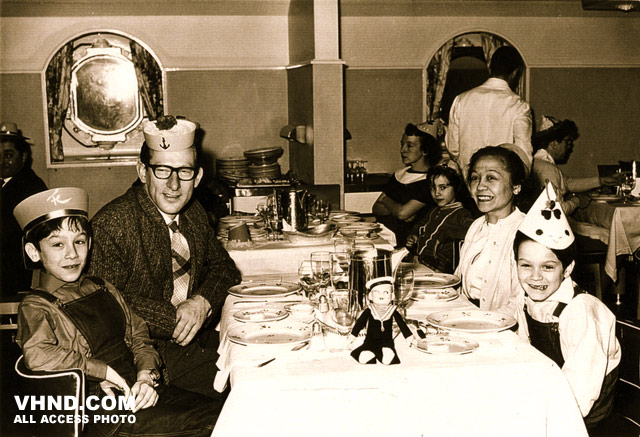
This truly historic photo was taken on the very boat that carried the Van Halen family to America. Left to right: Alex, Jan, Eugenia and Edward.
Jan and Eugenia risked everything by taking their two beautiful boys and immigrating to America. Once they settled in Pasadena, California, they continued to inspire his boys to become musicians.
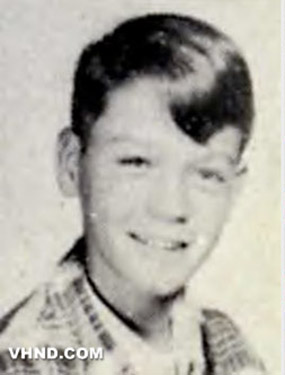 From the age of seven until the age of twelve he was trained in classical piano by his father and elderly Russian teacher, Stass Kalvitis. Eddie and Alex hated the commute, but continued as their mother would discipline them if they refused to go. Van Halen revealed in an interview that he never could read the music. Instead, he learned from watching and listening. During recitals of Bach or Mozart, he would simply wing it.
From the age of seven until the age of twelve he was trained in classical piano by his father and elderly Russian teacher, Stass Kalvitis. Eddie and Alex hated the commute, but continued as their mother would discipline them if they refused to go. Van Halen revealed in an interview that he never could read the music. Instead, he learned from watching and listening. During recitals of Bach or Mozart, he would simply wing it.
From 1964 through to 1967, Edward won first place in the annual piano competition held at Long Beach City College. Afterward, the judges would comment that he had an interesting interpretation of the classical piece. Van Halen’s view was, “What? I thought I was playing it correctly!” However, according to one interview, playing the piano did not prove to be challenging or interesting to him.
By the age of twelve Ed had discovered rock and roll. Inspired by the Dave Clark Five’s “Glad All Over” and “Bits and Pieces,” he decided to become a drummer. Alex began playing the guitar, Edward bought a drum kit and began practicing for hours every day. But that didn’t last—soon the brothers figured out they would both be better off switching instruments. Eddie began learning how to play the electric guitar. The first song he played was the Ventures’ “Walk, Don’t Run”. He also took up the violin and cello at this time.
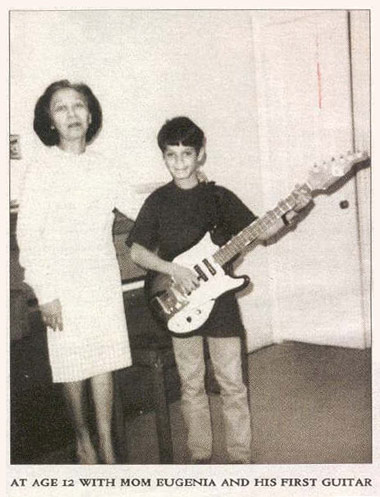 A friend of Jan Van Halen built an amp for Ed, and for the first time he was plugged in. One of the first songs played through this amp was the Arrow’s “Blues Theme.” The amp was short-lived, though, and in 1969 Ed bought his Marshall amp, which has since become the most famous amp in rock history.
A friend of Jan Van Halen built an amp for Ed, and for the first time he was plugged in. One of the first songs played through this amp was the Arrow’s “Blues Theme.” The amp was short-lived, though, and in 1969 Ed bought his Marshall amp, which has since become the most famous amp in rock history.
As a teen, he would often practice while walking around at home with his guitar strapped on or sitting in his room for hours with the door locked.
Eddie’s first favorite band was Cream. A Clapton fanatic to this day, he took it upon himself to memorized and perform Cream songs note-for-note. He became locally famous for it. Clapton wasn’t his only influence, though. Jimmy Page seemed to embody more of what Ed was really about, feeling over accuracy. It was Page who inspired Eddie to develop his tapping technique. “I’ve always said Eric Clapton was my main influence,” Van Halen said, “but Jimmy Page was actually more the way I am, in a reckless-abandon kind of way.”
Jimi Hendrix seemed to perplex Edward, however. Although he liked Hendrix’s whammy bar techniques enough to build on them within his own style, Ed was never comfortable playing Hendrix’s songs.

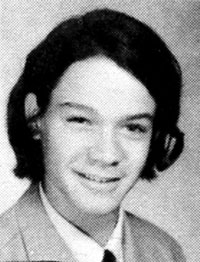 Van Halen and Alex formed their first band with three other boys, calling themselves The Broken Combs, performing at lunchtime at Hamilton Elementary School in Pasadena, where Van Halen was in the fourth grade. Van Halen would later say that this was when he first felt the desire to become a professional musician.
Van Halen and Alex formed their first band with three other boys, calling themselves The Broken Combs, performing at lunchtime at Hamilton Elementary School in Pasadena, where Van Halen was in the fourth grade. Van Halen would later say that this was when he first felt the desire to become a professional musician.
In these early years Ed was both a guitar player and a lead singer for his band Mammoth, nicknamed Junior Cream. Ed hated singing lead, though, and the lineup of Mammoth changed to include David Lee Roth.
“I never technically learned how to sing,” Ed remembered on the Drew and Mike show on Detroit’s WRIF in 1996. “So, I would kind of do a Kurt Cobain, after five songs and three beers my voice would be gone. You know, I would just scream it out and kind of waste my voice.”

 The band transformed from a high concept technical band to a hard pounding party band. By 1974 Mammoth was an established band on the local scene and Eddie had developed his tapping technique into a recognizable, unique style. This is not to say that Eddie was the only one tapping at this time. Several musicians had been doing similar techniques for decades. Tapping was not new, but Eddie didn’t know that. He developed his own style independent of outside tapping influences. It was this style that brought the technique to the forefront of rock guitar in the late 1970s.
The band transformed from a high concept technical band to a hard pounding party band. By 1974 Mammoth was an established band on the local scene and Eddie had developed his tapping technique into a recognizable, unique style. This is not to say that Eddie was the only one tapping at this time. Several musicians had been doing similar techniques for decades. Tapping was not new, but Eddie didn’t know that. He developed his own style independent of outside tapping influences. It was this style that brought the technique to the forefront of rock guitar in the late 1970s.
Rather than helping the band, Ed was actually keeping the band from getting the best gigs. When they became known as Van Halen, they tried to get gigs at the popular Los Angeles clubs, but Eddie was too loud. He had to be. In order for his Marshall to sound its best, it had to be turned up to 10 at all times. To rectify this Ed would turn his amp around or put padding in front to muffle the sound. Later, Ed used a Variac to adjust the voltage instead of the volume, so the amp would always sound its best. Eventually it all paid off and the band was accepted into Gazzari’s. Other prestigious gigs followed as the band spent about three years working the club circuit.

During the club years the band recognized the talent they had in Eddie. Alex and David suggested that Eddie should probably conceal some of his more innovative techniques from the audiences, which at times included guitarists from all over the L.A. scene.
“Yeah, that is kinda like Alex telling me, ‘Hey, wait until we have it on a record; their gonna rip it.'” Ed recalled. “Ya know, when I started doing the two-hand technique, as soon as the record came out, everyone did it.” (WRIF, 1996)
Van Halen’s Early Days at Gazzarri’s—As Told by The Band, Bill Gazzarri, Rodney Bingenheimer…
It wasn’t long before there was a buzz around town about this band and their amazing guitar player. It wasn’t until after the band had been discovered that “Eruption” was unveiled to producer Ted Templeman. Ted saw the potential of the ground-breaking instrumental and soon guitarists from around the world, in their studios and in their garages, would be spending countless hours trying to copy it. Over three decades later, “Eruption” was voted the “Greatest Guitar Solo of All Time” by the readers of Guitar World.
Ed was just getting started. His talent has never lied in any one technique, but in his ability to translate the sounds in his heads to the guitar. If that means coming up with a new innovative technique to achieve that sound, so be it.
While on tour in support of their debut album, Van Halen, Ed added another innovation to his repertoire. It was a combination of tapping and harmonics that came to be known as “False Harmonics.” Again, this was a technique Eddie developed independently, though it had been used by Jazz guitarists since the 1950s. The technique can be heard most prominently on the track “Dance the Night Away.”

At the end of 1979 Ed was voted Guitar Player’s Best Rock Guitarist. He had enough money to retire his father and buy him a boat. Eddie resurrected “And the Cradle Will Rock,” a song he and Alex struggled with in 1974, with keyboards for the band’s 1980 album Women and Children First. Though the keyboards were subtle, it marked a new beginning for Eddie. He refused to be confined to the guitar to express his musical ideas.
The band embarked on the World Invasion tour. It was on this tour that Eddie met Valerie Bertinelli backstage at the Hirsh Memorial Arena in Shreveport, Louisiana, on Aug 29th, 1980. Seven months later they were married. Rumors starting spreading that Roth was unhappy with Ed’s new lifestyle. Ed wasn’t exactly the member of Van Halen expected to marry a famous actress or hang out with Hollywood’s A-list.
Eddie’s personal life was going well, but his life in Van Halen was getting worse. He was frustrated that he hadn’t been expressing himself fully on the last few Van Halen albums. The party was over. After recording three albums and going on three tours in three years the band was set to do the same thing for the fourth album Fair Warning. Ed was admittedly depressed and made it clear to some that he no longer wanted to be in the band. During the recording of Fair Warning, he would often sneak into the recording studio late at night and rerecord his guitar parts the way he wanted them. He feared that the rest of the band wouldn’t approve of some the musical risks he was taking in his solos. He even included a haunted growling keyboard instrumental called “Sunday Afternoon in the Park,” that truly made this Ed’s album.
What came out of the recordings was a dark, heavy guitar album that many die-hard Van Halen fans consider the best guitar album of the Dave-era albums. However, it was the least popular in terms of sales. Ed was more reluctant to step out and take control for the next album and instead concentrated more on making guitars and refining his own position in the band.
There were excuses now to set aside Eddie’s style on the next album and go back to the formula that sold albums: covers plus lots of Dave equals record sales. To a certain extent they were correct, but the band suffered musically. They were determined to get back the legions of adoring pop fans and the result was 1982’s Diver Down, Ed’s least favorite album. He rarely liked cover tunes and this album was loaded with them. Ted wanted to use an original composition written by Ed for a cover, “Dancing in the Street,” something Ed would later regret terribly.
In late 1982, Van Halen was invited by producer Quincy Jones to contribute the guitar solo for Michael Jackson’s recording for Thriller’s “Beat It”. Van Halen improvised and integrated the familiar Van Halen-style guitar solo bridge in the new song. Part of rock lore was that credit for his work on the noteworthy track was sufficient and Van Halen declined the payment he was offered for his performance.
Tensions in the band between Eddie and Dave were now coming to a head. The building of the 5150 Studio marked the beginning of the end of the power struggle between Ed and Dave. Constructed in March of 1983, 5150 has been the recording studio every Van Halen album has been recorded in since. It lies just down the road from Ed’s house.
The result of the struggle within the band for freedom of expression was 1984.
Full Blast & Top Down: The Making of 1984
After six albums with vocalist David Lee Roth, the band enlisted new vocalist, Sammy Hagar, in 1985, giving Ed more freedom to explore different styles of music and to stray a bit from his expected position atop the heap of ’80s speedster guitar heroes. Even with those changes, Eddie only got more and more popular.
The next big change for Eddie didn’t occur until 1990. In January he entered rehab. He said in many subsequent interviews that he drank to take away his inhibitions, whether they were in the studio or on stage. It didn’t work out and Ed continued to drink, but other changes managed to take hold on his life over the next few years.
Valerie Bertinelli gave birth to Wolfgang William Van Halen on 3/16/91, “Wolfie” as his parent’s call him. At the same time, the 5150 Studio was remodeled and Ed began work on a line of guitars and a new amp.
The result of all of these changes was 1991’s For Unlawful Carnal Knowledge. The album exhibited a new style and sound that was embraced by both the press and the fans.
Years of touring followed which included the release of a live album as an excuse to tour even more.
Ed’s drinking was still a problem though. Before he could give it up, he had to want to give up. That hadn’t been the case until 1994. One night in 1994, while drunk, Eddie cut off his hair. It was an act of frustration that Ed would confuse reporters with by saying he did it on a bet. Actually he enjoyed the way his new look protected him from fan recognition on the streets. Shortly after this, Eddie sponsored a charity golf tournament and concert, the only public Van Halen performance that year.
When Eddie stopped drinking in 1995, he began to become more aware of a pain in his hips. All the years of jumping on stage had deteriorated his hips and the alcohol had only helped to cover up the pain. After losing some weight, the pain subsided and a hip operation was postponed until November of 1999.
After one live and four studio albums, Sammy left the band, but came back for the Best Of Both Worlds greatest hits CD and tour in 2004.
In 2005, Ed and wife, Valerie Bertinelli, filed for divorce.
In 2007, Van Halen reformed with vocalist David Lee Roth and with Wolfgang Van Halen replacing Michael Anthony on bass. Van Halen toured the U.S. and Canada from September 2007 through summer 2008, which resulted in their highest grossing tour ever.
On June 27, 2009, Van Halen married Janie Liszewski, an actress and stuntwoman who became Van Halen’s publicist in 2007.
Van Halen released their twelfth studio album, A Different Kind of Truth, on February 7, 2012, their first album in 14 years and their first album with David Lee Roth since 1984. The album debuted at #2 on Billboard. The band toured during the first half of 2012, until Eddie underwent an emergency surgery for a severe bout of diverticulitis. After Ed recovered, the band played a few dates in Japan, Australia, and the U.S. in 2013.
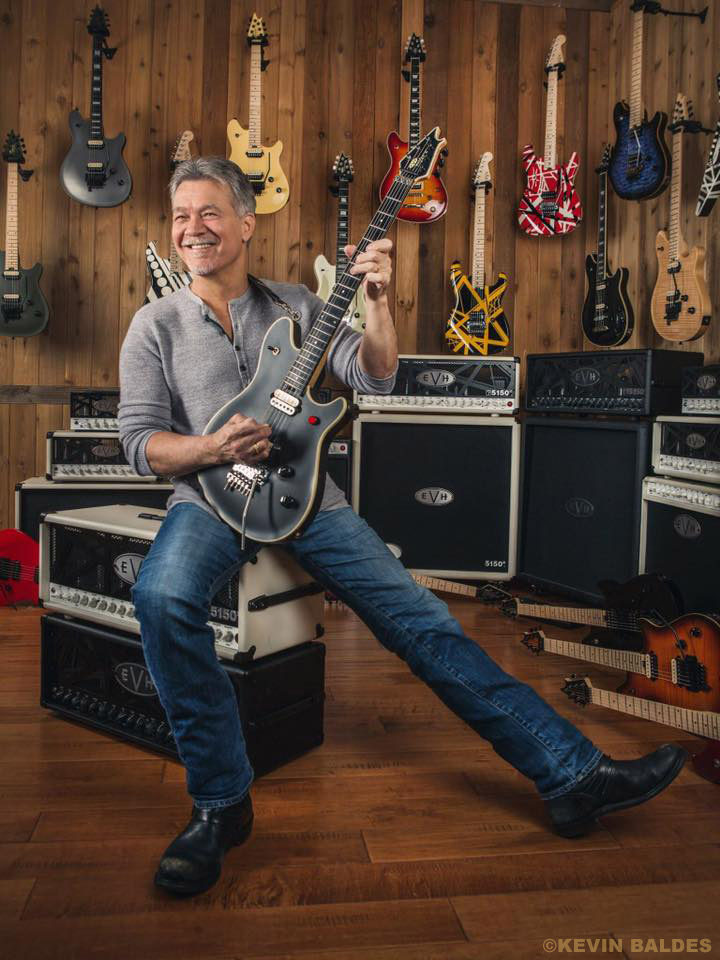
On February 12, 2015, Edward spoke at Washington, D.C.’s Smithsonian National Museum of American History and Zocalo Public Square as part of the institution’s “What It Means to Be American” series.
The Dutch immigrant and naturalized U.S. citizen discussed his American journey, his role in creating one of the biggest American rock bands of all time, and how he has reinvented the way the guitar is played and designed. He also answered the question, “Is rock and roll about reinvention?” And, he played guitar!
Watch the professionally shot video, and see photos from the event HERE.
After the Smithsonian appearance, Ed, Al, Wolf & Dave head out for a successful 2015 Summer/Fall Tour.
Tragically, Eddie Van Halen passed away on October 6, 2020, after a long battle with cancer.